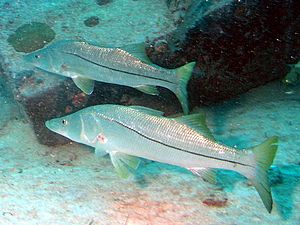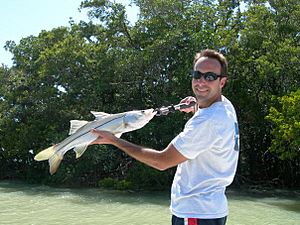Common snook facts for kids
Quick facts for kids Common snook |
|
|---|---|
 |
|
| Conservation status | |
| Scientific classification | |
 |
|
| Range map of the common snook | |
| Synonyms | |
|
Sciaena undecimalis Bloch, 1792 |
The common snook (Centropomus undecimalis) is a cool type of fish that lives in ocean environments. It belongs to the snook family called Centropomidae. People also call the common snook the sergeant fish or robalo.
This fish is one of the biggest snooks around. It can grow up to about 4.5 feet (140 cm) long, but usually, they are about 1.5 feet (50 cm). The largest common snook ever caught weighed over 53 pounds (24.32 kg)! Snooks have a plain color, but they have a clear black line along their side. Sometimes, their belly and tail fins can be bright yellow, especially when they are ready to lay eggs.
Contents
How Snooks Live and Grow
Snook Reproduction
Common snooks have a unique way of reproducing. They are "protandric hermaphrodites." This means they start their lives as males and can later change into females.
Snooks usually lay their eggs between April and October, with July and August being the busiest time. They like to lay eggs in salty waters near the coast. After the eggs hatch, the young snooks, called juveniles, move into brackish water areas like estuaries. Estuaries are where fresh river water mixes with salty ocean water. When these young snooks grow up, they return to the saltier ocean waters to join the adult fish and lay their own eggs.
Where Snooks Live
Common snooks depend on both estuaries and fresh water. Young snooks often live in coastal ponds, island networks, and creeks within estuaries. Even though they can live in both salty and less salty water, young snooks prefer water that isn't too salty. They are very good at adapting to different water conditions.
Snooks are also opportunistic predators, meaning they eat whatever food is available. As they grow bigger, they tend to eat larger prey. Sometimes, snooks might even eat smaller snooks, especially in winter when adults and young fish are close together. This is rare, but it happens if the young snooks are the biggest food source around.
Snooks and Their Environment
Snooks are very sensitive to changes in their surroundings. Even small changes can affect their behavior. For example, they know when to start laying eggs based on water temperature, how much rain there has been, and if the moon is full.
However, big changes can be harmful. Snooks are very sensitive to cold water. If the water gets too cold, they stop eating. If it gets even colder, they can lose their balance, and if it drops below 54.5°F (12.5°C), they can die. For example, a cold snap in 2010 caused a big drop in the number of snooks in southwest Florida.
Where to Find Snooks
C. undecimalis live in the warm, tropical waters of the western Atlantic Ocean. You can find them from the coast of North Carolina all the way down to Brazil, including the Gulf of Mexico and the Caribbean Sea.
Snooks likely first appeared in Central America. As the Earth's climate changed after the Ice Age, snooks moved north into Florida. They followed the coastlines around the Gulf of Mexico. You can find very large snooks in Central America.
These fish live in shallow coastal waters, estuaries, and lagoons, sometimes going into fresh water. They are carnivores, which means they eat other animals. Their diet mostly includes smaller fish, crustaceans like shrimp, and sometimes crabs.
Snooks and People
Snooks are considered a great fish to eat. They are caught by commercial fishermen, and you can buy foreign-caught snook in the US. When you cook snook, it's important to remove the skin because it can make the fish taste unpleasant, almost like soap.
Snooks are also very popular game fish for anglers because they are known for putting up a strong fight. The world record for a common snook caught by an angler weighed 53 pounds 10 ounces (24.32 kg)! Anglers use different lures like jerkbaits, jigs, and live bait to catch them.
Three United States Navy submarines have been named after this fish: USS Robalo (SS-273) and USS Snook (SS-279) during World War II, and USS Snook (SSN-592) in the 1950s.
Protecting Snooks in Florida
In 2010, a very cold winter caused many snooks in Florida to die. Because of this, the Florida Fish and Wildlife Conservation Commission (FWC) decided to close the fishing season for snooks in the Gulf of Mexico. This meant people could not keep snooks they caught; they had to release them. This closure lasted until August 31, 2013, to help the snook population recover.
After that, the FWC allowed recreational snook fishing to reopen in the Gulf of Mexico starting September 1, 2013. The commercial catching or selling of snooks is still not allowed under these rules. The FWC planned to check the snook population again in 2015, but as of June 2016, this check had not happened, keeping the fish under a protected status.
- Froese, Rainer and Pauly, Daniel, eds. (2004). "Centropomus undecimalis" in FishBase. October 2004 version.
See also
 In Spanish: Róbalo común para niños
In Spanish: Róbalo común para niños



